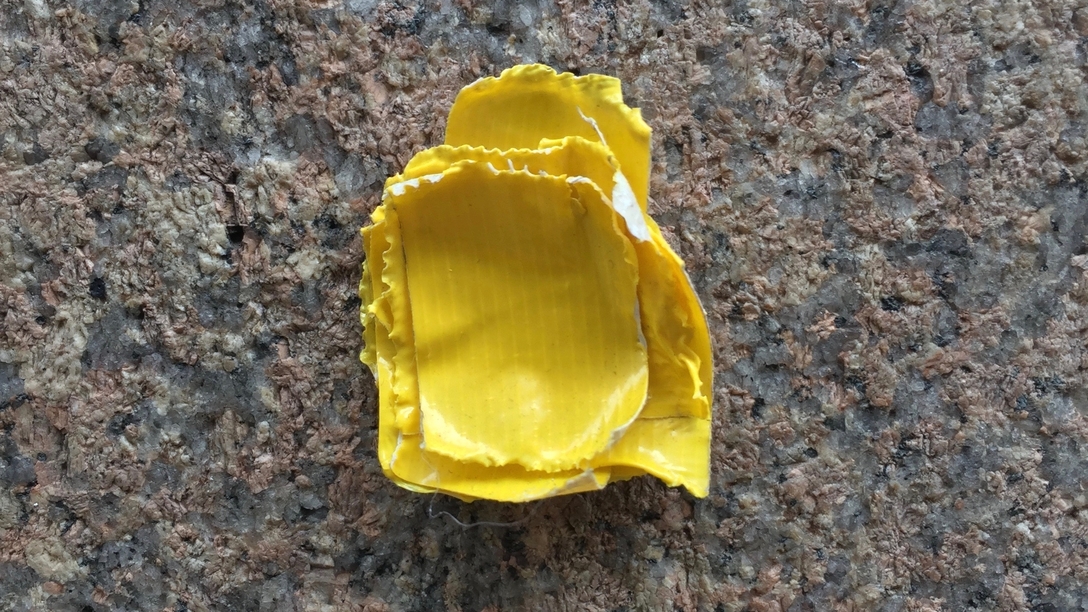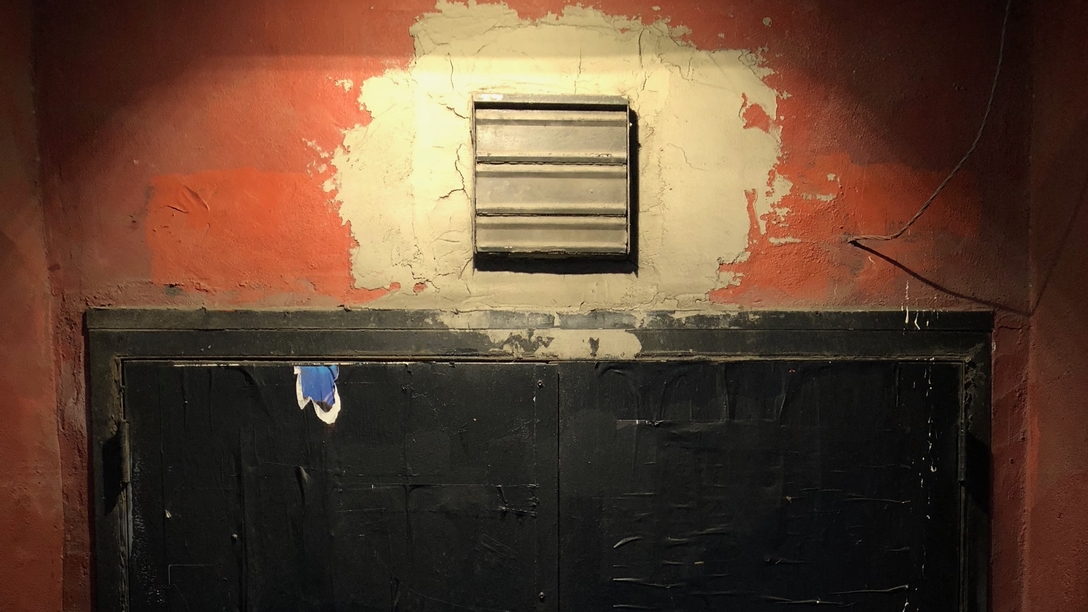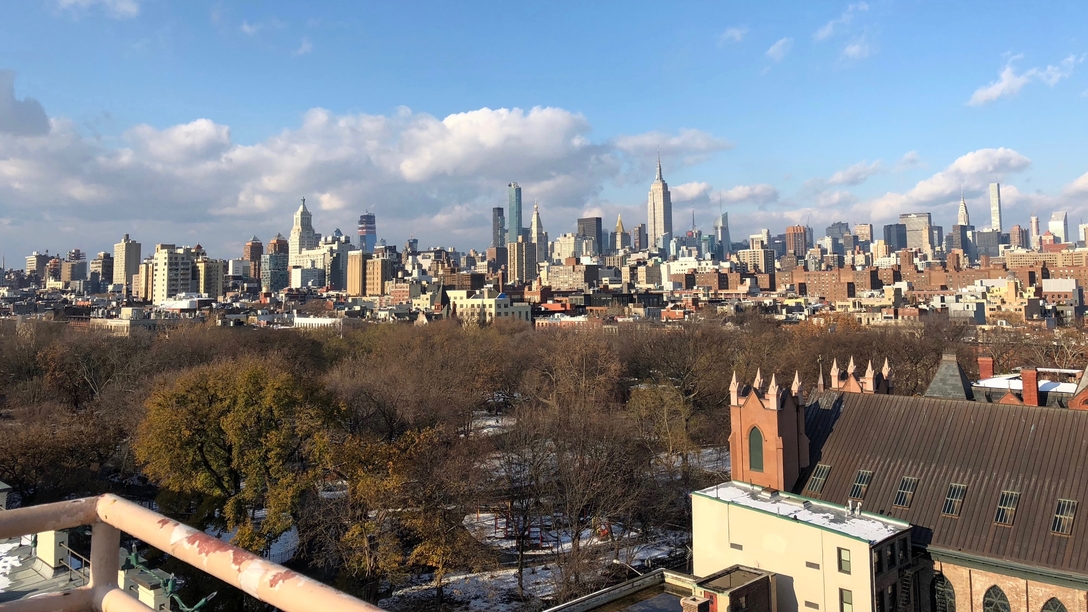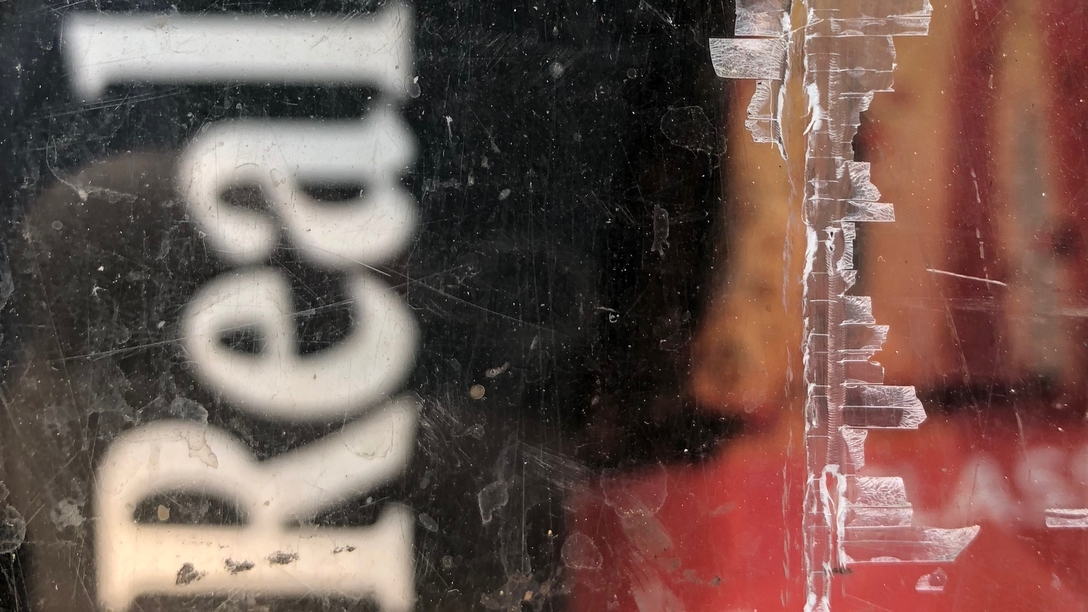A
It’s never these four—me, Heidi, my Sam, and my Jonah. Sam is a college junior and we’ve seen him twice this year. Jonah is a high school senior and basketball comes first. Heidi’s kids, Sam and Piper, are with their father for Thanksgiving. Today, this is the cast.
My room in Gowanus is one of eight in a communal loft. The sunlight floods in from the southwest and hits the white walls. I see everything I think I want to see, including the books I can unfold on an eight-foot desk my roommate made from scrap lumber.
Sam is down from college, which feels rare. I think the boys are not around enough, but they are probably around as much as they need to be. If I catch myself saying a thing, I send it up my sleeve.
Sam and Jonah show up at 1 p.m. Jonah is wearing a close-fitting acrylic Polish football starter jacket. Sam is wearing a plaid shirt and a thin, woodsy coat. Jonah sits in a black leather wing chair my friend Ava lent me. Sam flops onto my bed. We talk about whether to keep the bed on the floor or put it up in the loft.
Heidi arrives with three plants, one leggy, two juicy. Sun-lovers, they are low on needs and good for an inconstant waterer. They go onto the concrete sill. I give Heidi a warm seltzer.
I don’t know who is or isn’t happy, but I think it’s reasonable to say we want to be together. The time is light and slow. Perhaps I slept enough. Maybe, for a moment, I am not anxious.

B
I thought I would be rid of benzos on November 24, 2016. I missed that mark, but on May 1 of 2017, I stopped taking any of the drugs in the benzodiazepine family. These include Xanax, Valium, and Klonopin. These are tranquilizers, sedatives, things that blanket you. Someone you know takes them.
November 23, 2017, was my first benzo-free Thanksgiving since November of 2004, when I was still married and doing the holiday at my wife’s parents’ house in Weston.
The story of being on benzos and then trying to not be on them is long, but the executive summary goes by quickly. Although much is known to many about the dangers of long-term use, quitting benzos is still not a popular form of quitting. There are robust communities for those who want to be rid of alcohol or heroin or cocaine. Strangers will high-five you if they see a black plastic “Keep Coming Back” keychain fob or if they hear you saying “I’ve got a year.” Benzos, though, are a liminal influence, neither aspirin nor heroin, not afforded the room to acquire their own dramatic characteristics. They are popular enough that there is still not a consensus view of the downside.
More importantly, benzos are correlated with morbidity more often than mortality. If someone can overdose on a drug, it can be stigmatized. Barbiturates fell out of favor in the early sixties after highly visible people, like Marilyn Monroe, overdosed and died. A handful of Xanax, by itself, will generally make you space out and fall asleep. If it doesn’t lead directly to death, a drug will likely stick around for as long as it proves either profitable to manufacturers or useful to consumers. Decay doesn’t count in America—just death.
Even skeptics allow that benzos are good at canceling out fear during brief events: airplane rides, public speaking engagements, the wait before an operation. Over long stretches, though, benzos can induce chemical dependence, memory loss, and hellish withdrawal symptoms. This isn’t so different from alcohol, which rides a similar rail. Plenty of people drink without life-ending results. A small cohort is even paid to write about the very best boozes you can buy. For others, recovering from drinking is a full-time occupation, and these two narratives coexist. On one side, the sippers and sniffers; on the other, the dark nighters, whose best hope is getting out alive. Americans have room for this kind of cognitive dissonance—just not with benzos. Benzos haven’t managed to pick either lane, let alone both.
There is no Jesus’ Son of benzos. There is no equivalent of The Insider for the crusader speaking truth to Pfizer. There is no devil in benzos, no God. Benzos do not fill the soul or speed the plow. Benzos are a presence whose most acute characteristic is absence: the lack of pain, the quieting of nerves. There is no benzo psychedelia, no benzo kitchen-sink drama. Take them out of your bloodstream, though, and they will turn your brain inside out like a pocketbook on Sunday morning. That story just doesn’t sell. When Grace Slick sang about Valium in 1965, the pills “that mother gives you,” the ones that “don’t do anything at all,” that characterization stuck.

Valium was introduced by Hoffmann-La Roche in 1963. Between 1968 and 1981, it was “the most widely prescribed medication in the Western world,” as Andrea Tone states in her 2009 book, The Age of Anxiety. Almost as soon as it was introduced, Valium had its detractors. Patients found themselves addicted, quickly, and found the withdrawal symptoms extreme. In 1978, Cyndie Maginniss was featured on the NBC Nightly News. Maginniss had been prescribed Valium for her anxiety and was taking increasingly large doses in short order. Her dependence grew, and the side effects of the Valium began to outweigh the benefits. As quoted in The Age of Anxiety:
“My body was completely out of whack,” Maginniss told the NBC reporter. “Why did you wait so long before seeking help?” the reporter asked. “I thought I was taking medicine,” Maginniss replied.
TV producer Barbara Gordon told a similar story about Valium dependence and withdrawal in her 1979 memoir, I’m Dancing as Fast as I Can, which became a movie starring Jill Clayburgh in 1982.
By the early eighties, the American public was aware that Valium could lead to dependence, disorientation, and hospitalization. The answer? Just change the name. In 1981, Upjohn introduced Xanax, a benzodiazepine structurally similar to Valium. Stronger but shorter-acting, Xanax addressed public fears about Valium zombies, even though Xanax was found to produce even more intense withdrawal symptoms than Valium. At the same time, other benzos were being prescribed for people recovering from drug use disorders. This is how Stevie Nicks ended up on Klonopin, which she eventually described as “more deadly than the coke.”
If nobody is dying and there are still new names and configurations to play out, a drug is viable. Even without a public relations problem, drug patents expire after 20 years, so profitable drugs need to be repackaged and reissued.
“The FDA can approve a new drug only if it treats an existing disorder,” Dr. Tone explained to me. “Pharmaceutical companies often promote the disease entity their drug has been approved to treat. In the United States, where direct-to-consumer advertising is legal, companies have used this strategy to amplify interest in the disorder and demand for their drug. It’s a great way to expand a drug’s market and boost company profits.”
The PR problems for benzos resurfaced, obliquely, following the 2017 deaths of Lil Peep and Tom Petty, both found with Xanax in their blood. The rep of Xanax is shaky enough that rapper Lil Xan briefly changed his name to Diego. Very briefly—his debut album, Xanarchy, came out on April 11, with no Diego in sight.
One complication, though, for anyone trying to figure out what these overdoses indicate is that benzos still don’t kill by themselves. A 2016 study found that “[b]enzodiazepine prescriptions and overdose mortality have increased considerably,” but this New York Times blog post clarified that “most of the deaths have involved opioid painkillers like oxycodone.” In 2016, the FDA issued a warning about combining benzodiazepines with opioids, a class of drug that has been afforded its own national crisis. Even a new and active bill in Massachusetts is using opioids to frame benzo risk education. Opioids, being lethal, are overshadowing benzos.

It is not difficult to imagine how we got here, because I know how I got here.
It is hard to quit something that your doctor tells you isn’t worth quitting. The man who put me on benzos in 2005 told me—in 2008, 2009, and again in 2012—that Xanax left the bloodstream after 24 hours and had no lasting effect. He believed the drug-company line that Xanax was short-acting, and apparently never thought much about what the accretion of the drug might lead to. He told me that if I was having trouble with the withdrawal symptoms that follow a lapse in dosage, I should stop taking the benzos and go crazy for a week, and that would be that.
That was not that.
Benzo withdrawal is not at all like a cold or a hangover or any other discomfort you know. If I hadn’t taken a benzo in the previous 24 hours, I would get light-headed. But not light-headed. I felt other-headed, attached to a pod that behaved according to rules I couldn’t decipher or change. I was unable to make the pod reattach itself. Whatever had become of my head or my brain—made the same by the Xanax—was separated from all the working bits by wires I couldn’t find.
Taking the Xanax just became a way of staving off the symptoms of withdrawal that Xanax created. Although this is often called addiction by benzo survivors themselves, it is more accurately described as chemical dependence. You don’t necessarily seek drugs or collect them in an effort to get more of them into you. You are on them and you don’t know why you can’t stop putting them into you.
As to the underlying condition I was treating with Xanax, who knew? The anxiety was obscured by the medication, so it carried on, fat and satisfied, behind the fogbank of Xanax, followed by the ax of short-term withdrawal. When everything is tallied, my anxiety was medicated for 12 years and simply got worse.
How much worse can benzos make it? Bad enough that, on March 18 of 1982, Andy Partridge walked offstage in the middle of “Respectable Street,” right out of his life as a live musician. From the 2018 Showtime documentary XTC: This Is Pop, here is an edited version of Partridge’s story, a perfect distillation of how terrifying benzo withdrawal—and talking about it—can be.
“Halfway through an American tour, the woman I was married to at the time looked at a big tub of Valium I had, and—when I finished a gig one night and went out drinking with some people in Los Angeles—she thought to herself ‘What is he taking this shit for? He doesn’t need it, doesn’t do anything for him, I’m gonna get rid of it.’ She tipped all these Valium down the toilet. I came home drunk to this grotty hotel room in Los Angeles. ‘I’m gonna need my Valium! Where’s my Valium?’ She said ‘I’ve tipped it all away. I don’t want you taking this crap anymore. You’ve gotta stop this stuff.’ I freaked out. I thought ‘Ah! That’s my crutch! What are you doing? I take that every day of my life. I’ve taken that every day since I was twelve, thirteen.’ Which I had done.”
“I was on it in the first place because my mother had a lot of mental problems, and the fallout from that was really fucking me up as a kid, big time. And it was the sixties and the new wonder drug, Valium. ‘Well, his mother’s crazy we’re putting her in a loony bin for while, poor kid’s upset he’s only twelve—tell you what, stick him on Valium.’ I was on Valium, addicted to this stuff since then, and here I am thirteen years later not registering that I’m addicted and thinking I can just stop.”
“Over the following year, I went into slow brain melt. I developed panic attacks, I had no idea what they were, memory loss, my limbs were seizing up, my whole world was going wrong because of this Valium addiction, coming off of Valium, stopping dead.”
“Just things came unwound, I was getting agoraphobia, I couldn’t go out. I was getting panic attacks, no concept of what a panic attack was, and I’m on stage and I’m getting a panic attack. ‘Aaah! Aaah! Why, why am I afraid of everything in the known universe?’ No concept of what was happening to me. And I found myself going on tour, touring around Europe, and then it was a tour of the States, and then it would have been Japan, Australia, bla bla bla, wherever, doing this with my brain dribbling out of my skull. All of these things going wrong in my mind and in my life and me not knowing what they are. I found myself on stage in Paris having the mother of all panic attacks and thinking, ‘That’s it, I’m going mad. Stop the world. I wanna get off.’ ”
For years, he referred to this situation as “stage fright.” But, in the five years preceding the Valium withdrawal, Partridge had played hundreds of shows. Stage fright is a deeply unconvincing explanation for what happened to him, but it was a phrase that people would have understood in 1982.
The conversation wasn’t much more common or clear in 2005. Had my doctor told me to work on meditation and breathing instead of giving me a prescription for pills, I would not have had to quit a drug that was linked to the onset of dementia and early Alzheimer’s in 2014. I did not look for studies like this, which is marginally different from avoiding them. I didn’t want to think about what was happening to my brain, because I knew nothing good was happening. Admitting the odds seemed enough.
When someone sent me a New York Times blog post about the study, I let it sit for days. The study said, “[w]hile the acute deleterious effects of benzodiazepines on memory and cognition are well documented, the possibility of an increased risk of dementia is still a matter of debate.” The study participants were roughly 1800 people in Quebec over the age of 66 who had been diagnosed with Alzheimer’s disease and whose “benzodiazepine use started at least five years before diagnosis was assessed.” It wasn’t hard to think this population didn’t have anything to do with me, even if there was scientific support for the universal applicability of the findings. I decided to believe. Changes to my memory were a done deal, but the dementia was still pending. There was a concrete point in quitting.
In December of 2017, another study was released. A meta-analysis of 19 studies, this paper concludes that “[t]he results of the study are important in that they corroborate the mounting evidence that a range of neuropsychological functions are impaired as a result of long-term benzodiazepine use, and that these are likely to persist even following withdrawal.”

If you want a brief, vernacular description of why benzos might be bad for your relationship to the world, separate from any physical damage accrued over the long term, here is a metaphor. Imagine that your anxiety is like having knife hands that you can never disable or detach. The Xanax or Klonopin or whatever acts as a plastic sheath, which is a good idea, insofar as you don’t want to cut yourself or others. But when the sheath comes off, you are left with knife hands that you don’t know how to use. The fact that the sheath more or less works does not change the nature of your knife hands. If you think the sheath is a good long-term solution to the knives of anxiety, problem solved.
The sheath is a combination of amelioration and suppression. The lessening of psychic pain is no small comfort—I like amelioration. The suppression of anxiety, on the other hand, is not real comfort. The companies that make pills like Xanax are supporting the implication that you might as well ignore anxiety because it is like the flu or a paper cut, an affliction from elsewhere, a thing that happens to a person rather than a condition that derives from being that person. In this light, there is nothing to understand about a condition, just more- or less-efficient treatments to buy for it. It is easy to sell that pill. It is much harder to sell the idea that you need to exercise discipline and careful observation or, hardest of all, that things suck sometimes, especially what with the knife hands. External, internal. If anxiety is rain, it makes sense to buy an umbrella. If anxiety is blood, umbrellas are dumb.
And yet, so many umbrellas. From that 2016 study: “Between 1996 and 2013, the percentage of adults filling a benzodiazepine prescription increased from 4.1% to 5.6%.” At least 5.6 percent of the American population (much more likely between 10 and 20 percent with all nonprescription usage) is taking benzodiazepines.
I didn’t know about anxiety in college. More specifically, I didn’t know that worrying was referred to, medically, as anxiety. What I wrote down in my 1985 journal was this: “THE GOLF BALL. WHERE DO YOU PUT IT?” My idea, then, was that anxiety was something that I could not get rid of. Not knife hands exactly, but a hard and uncomfortable thing that had to be accommodated. I had not yet guessed that anxiety was consciousness itself, like my tinnitus, a thing I could not shake, a thing I could only get used to.
I had my first panic attack in 1990, while crossing the Brooklyn Bridge. I was in a theater piece with some of my bandmates, playing the role of a band. I was drinking lots of coffee, smoking cigarettes, going through a breakup, and becoming claustrophobic in cars, which I didn’t yet know. Why would I become claustrophobic after not being claustrophobic? What the hell are brains up to?
While crossing the bridge in a cab, I became convinced I was having a heart attack. I jumped out of the car and lay down on the concrete divider that begins once you reach land in Brooklyn and have to choose between Cadman Plaza West and points east. I discovered some things: Ambulances are not free. I was not having a heart attack. Emergency room workers don’t like spending time on people who are only having panic attacks. Panic attacks were treated in 1990, as they as are now, with a small chalky oval called Xanax, the brand name for alprazolam.
I was given a small supply, maybe 15 pills, in a transparent orange can. Over a week, I took, at most, four of them. The experience was not optimal. I did not enjoy the rhythms of my brain being altered. I was smarter when I was 22. In the first few months of 2005, when my marriage was unraveling and my idea of a good idea was trying to smash an Apple printer on the face of a wooden floor (because these printers were once well made), I went to the doctor. Guess what he told me? Xanax. Xanax was his answer. And, this time, I believed this fool.

The difference between drugs taken by compliant users and those taken by recreational users creates a distinctly halved narrative. The compliant user is getting medicine (per Cyndie Maginniss) at pharmacies and taking it at prescribed times, in prescribed doses. The recreational user is a creator, finding and combining drugs in an area bounded only by the user’s physical limitations and ability to work a slightly darker web. The recreational user is not limited to drugs made by pharmaceutical companies. Visit the Reddit benzo forum and you’ll find discussion of “presses,” drug tablets made from whatever the drug is allegedly made of in addition to a slurry of unspecified fillers and enhancers, all of it physically shaped by a die press mold that approximates the look of pharmaceutical-issue drug tablets. The online sellers list these molds as tools used in the making of “candy.” Sweet Tarts and Xanax are not manufactured in such different ways—it’s a good cover.
The knife hands of anxiety are probably there to balance the work of life, and slow you down and stop you from doing dumb shit you can’t handle. Anxiety might be the opposite of a malfunction; it could be your self observing yourself, or the ego observing the ego, depending on which psychoanalytic school you subscribe to.
You buy typewriters, yell at cracks in the ceiling, and try to open tinned tomatoes with your teeth not because you think any of it is a good idea but because the border between ridiculous and plausible has been erased and everything feels more plausible than it feels erased. You do, actually, sense that things are wrong and these things should not be done—don’t buy 27 pairs of socks at one time—but the sense of that wrongness now feels like the anxiety feels: a thing that the Xanax allows you ignore.
What happens after years of taking Xanax is more or less what happens when you leave a jar in water for a day. The label soaks off. Xanax eats away at a surface that also senses, something between Bakelite and cilia. Without this surface, you can’t feel the thinking. Remove the benzos, and you start feeling your thinking again.
Good days now far outnumber bad days, and they are exquisite. Any particular moment can have both vividness and heft. Things have emotional value and take place at a rate that can be felt. On the increasingly rare bad days, I don’t even get to a stage where things have values. A panicked mist comes down and I loop in my head. “Being depressed” would be as good as “feelin’ great,” except neither of those states load. I end up with a variegated rainbow of nothing.
Now, in July of 2018, I am beginning to lose my connection to the particulars of being on benzos, the moment-to-moment sensations. I forget names and feel dissociated more often than I’d like, but I have no evidence these tendencies have anything to do with taking benzos for more than a decade. I’ve been spacey since childhood, and mechanical failures are more or less native. It is possible benzos are a storm system I passed through. There is little chance I will ever know with any certainty what the drugs did or didn’t do to me.
I first tried to write this piece in 2015, for an English newspaper. It made no sense, since I hadn’t kicked anything. Now, 45 years after my mother first called me a worrywart, I am confronting anxiety, as what it is, in all its shapes, without medication. I’m looking for the space outside anxiety, a gap where I can plant myself and watch.

My view of benzos is the stuff that isn’t routinely woven into reporting or studies, a view that benzo survivors characterize as “patient experience.” Discussions of drug use are threaded around the pins of mortality and other functions suited to clinical testing. The strength of the brain, in this setting, is reduced to “recent memory, processing speed, visuoconstruction, divided attention, working memory, and sustained attention,” to cite the variables Simon Crowe and Elizabeth Stranks measured. These are capabilities that can be tested, and that ability to be tested makes them able to be brought into a conversation about medical goals, in a way much of the brain is still not. In an instance of health risk, there is often a collective desire to move from the particular of the personal experience to the general of representative data, in order to either bring new treatments to the general public or allow them to buy a bunch of shit. I only have the former, the particular.
I quit benzos through tapering. This method was not suggested by a medical person. Even sympathetic doctors who thought it was a good idea to quit benzos had no advice as to how I might do it, and they had nothing to tell me about what to expect. No doctor mentioned “The Ashton Manual,” a guide to quitting benzos first issued in 2001 and written by Dr. C. Heather Ashton, a professor of psychopharmacology at the University of Newcastle upon Tyne, a person who is now retired.
After a flurry of concerns and litigation in the seventies, the topic of benzodiazepine damage fell out of the mainstream media diet in America, but in England, it’s still tabloid material. Perhaps when an American celebrity does something daft on benzos and the New York Post realizes a zombie joke can be made, the conversation will grow. More likely, if Americans start seeing benzos as harmful in and of themselves, the way Americans now see cigarettes, there will be a change in behavior. This seems unlikely. We love sedatives. We love cigarettes, too, but we also seem to accept that they kill us, slowly. We still think we are smarter than sedatives.
I got my tapering information from Bluelight, “an international message board that educates the public about responsible drug use.” (Bluelight established a relationship with the Multidisciplinary Association for Psychedelic Studies in 2013.) Some of the boards are keyed to recreational users who want to know why a bag of stepped-on coke smells like benzene, or how to identify fishscale. Habitual users also have concerns, one of which is quitting the drugs being discussed. (These anxieties are grouped into one forum called “The Dark Side.”) Bluelight members address the entire cycle of introduction, habituation, and rejection. I found the people who had rejected benzos.
Some of the talk about benzos contained references to titration, the adjusting of dosages until a “proper” level is found. In terms of quitting, titration is finding the minimum amount to stave off withdrawal symptoms, the place you rest before the jump. The process of decreasing dosages is also called tapering, weaning, and reduction—all ways of making an adjustment and then measuring the effect of that adjustment.
Nobody on Bluelight was enthusiastic about going cold turkey, though kicking is always a version of going cold turkey. Colin, founder of the popular BenzoBuddies Community Forum, posted an explanation of why going cold turkey is a bad idea in 2012. Colin writes, “Cold Turkey refers to the sudden (or near sudden) cessation of a drug. In the case of benzodiazepines, except after very short-term use (days, or a week or two), this is potentially very dangerous. . . . The higher the dose, and the longer you have been taking them, the greater the risks associated with sudden withdrawal. You should not alter your dose of benzodiazepines without first consulting with your doctor.”
When I began reading the Bluelight boards, I saw mention of seizures and heart attacks, though nobody posting had experienced either. The chances of getting through cessation seemed OK if I tapered down to the minimum. And then I’d have to jump.
In May of 2017, my Valium prescription ran out. I had a vague plan to renew the prescription once more, make it to summer, and then quit. This plan was clearly no more sound than any other. Now was the time. My mantra was simply “Don’t die.”
I lost my spot in a loft and bounced between friends’ places and cheap tourist hotels in Midtown. (The Apple Core chain of hotels has some bargains. Airbnb does not.) I ended up in a flat near Columbia University for a month. The trees and plants in Morningside Park were my sentries. Every morning, trying to reabsorb what little sleep I’d gotten, I’d walk out and look at the green. A scaffolding was being put up at the base of the building. If I was lucky, I’d see the woman from the second floor who liked to complain to the workmen about the view she was losing. My encounter with the plants was a check-in, proof that I was alive and able to feel.

A
It is a normal day, and that is the story of this Thanksgiving. There is nothing hidden in the folds—the day I remember is the day I experienced is the day that happened. Benzos erase this line.
We walk to the deli on the corner to get a banana, cold seltzer, and nuts. This spot is called Sandwich Factory. The first time I went in, I ordered a bagel and was a dollar short. The proprietor said I could bring the money next time. “I see you all the time, it’s OK.”
We walk north, away from Gowanus and into Fort Greene. We go down South Portland Avenue through a tunnel of plane trees and hit the house where I lived in the seventies. I’ve told the boys about this house plenty of times before. When I tell them about this house, what do I want them to think or feel? They are polite, as I would be. It’s a house.
The point of our day is to eat at Junior’s, our holiday spot since I moved back to Fort Greene in 2008. In the seventies and eighties, I ate open-face roast beef sandwiches there, and now my boys do the same. The Shirley Temples still come with dopey fat maraschino cherries, and the tables are still set with bowls of pickles, beets, coleslaw, and cornbread, more than enough to make a meal before you order a thing.
Today is the first time we’ve showed up at Junior’s on the holiday itself. The front door is manned by a bouncer, not because the restaurant is swamped but because there is a line of 57 people waiting to pick up cheesecakes. When I approach the front door, the bouncer waves me down the sidewalk toward the bar entrance. I know this is wrong, but he’s dealing with a lot. Stress is manifesting in the cheesecake line. We say thank you and go in through the bar entrance.
A woman acknowledges that I’ve made a reservation but doesn’t look anything up. She simply grabs four menus and finds us a table, not in the main dining room. It seems like the wrong day to complain.
When we sit down, a white man in his sixties is twisting around on the banquette to our right. “What is this, the Batcave?” he says, getting up. His journey takes him around the restaurant, and he does not seem to find what he wants, though the experience of walking through the restaurant and complaining may be exactly what he is looking for.
To the other side, we’ve got a man in his fifties with a woman half his size, roughly 800 years old. He speaks too loudly, and she speaks in a voice that seems adopted, like the mother in No Country for Old Men, minus the twang; a pinched Old Person Voice. She is explaining to her companion why she does not like Paul Newman. She did not ever meet Paul Newman, it turns out. She had no truck with Paul Newman, none, but her friend did. It turns out that her friend went with his wife down the street, chasing Mr. Paul Newman. When they came face to face with Mr. Paul Newman, he refused to sign an autograph. This seems to be the entirety of the story and the entirety of her case against Mr. Paul Newman.
“That’s why I do not buy his popcorn and his dressing and his movies. I do not do it.”
Heidi and I order the Thanksgiving plate, a turkey and fixings dish not so different from the one offered year-round at Junior’s. It is generous and thick and steaming and as satisfying as a plate of food can be. The boys order Reubens, which are gigantic and good. We could be shelled at this point and we’d find a way to deal with it.
In a Lyft on the way back to Manhattan, our driver engages Sam in a question about the paintings hanging at his college. I am only half listening and become convinced they are talking about the Wyeth painting Christina’s World. Like a donut, I bark, “WYETH!” Jonah and Sam laugh for a while and then make it clear that they are talking about someone else. The driver decides to agree with me, the person who is wrong.
“I should know,” he announces. “I’m an artist.”
When we get out of the car, in front of our house on East 7th Street, we see a woman in a tight black jacket chasing a toddler in slow motion, singsonging, “Baby want money?” The child is maybe three and is laughing and doesn’t seem to need any cash.
Sam hangs out for a moment and then splits to take the train up to Connecticut. Jonah tolerates my murder spa white noise for a few minutes and then puts on his “Ric Flair Drip” Spotify playlist. He asks to watch Black Mirror with us, and we end the day with “Nosedive,” an episode about being downvoted on social media. In this near future, a lack of likes can worry the breath out of your life. Imagine that.






